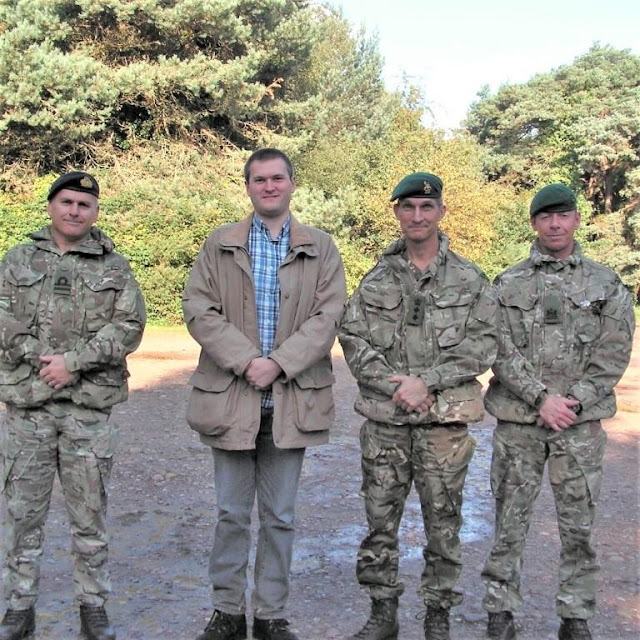WW2 75.6: A small town on Woodbury Common
Military historian Simon Fogg took senior staff from the Commando Training Centre Royal Marines (CTCRM) at Lympstone on a tour of the old World War Two Dalditch Royal Marines Training Camp in October 2019
While Budleigh Salterton remained relatively quiet during the Second World War, only a few miles away was a hive of military activity.
Exmouth resident Simon Fogg has made himself
into an acknowledged expert on Woodbury Camp.
He has always had a love of military history and has been a dedicated
rifle target shooter from a young age.

Simon with his first book Wartime Dalditch Camp and Finds On Woodbury Common, published in 2016
It was through this activity that he developed a fascination for the Common as a site for discovering military artefacts.

Simon with his first book Wartime Dalditch Camp and Finds On Woodbury Common, published in 2016
It was through this activity that he developed a fascination for the Common as a site for discovering military artefacts.
Simon’s second book, entitled Inside
Dalditch Camp, A Wartime History Of The Royal Marines On Woodbury Common, was published last year and is, in his words, ‘over twice as thick and stuffed with info!’, consisting of
236 pages with full colour.
As in the first book, there are illustrations of
wartime finds from the site and more historical detail including information
about Blackhill Camp, which was erected on Woodbury Common in the 19th Century.
The history of the Dalditch Royal Marines Camp during World War II covers the
various areas of the camp including the decontamination buildings.
The
decontamination building: one of the last standing structures in Dalditch Camp
Above you can see one of three - originally four -
decontamination buildings. The biggest fear of German attack was gas bombs or
nerve agent spray from low flying aircraft. This building would have worked
like an enclosed shower room.
In the event of such an attack, the personnel
affected would be evacuated to the building to be thoroughly cleansed in the
aftermath. Originally, each of the buildings would have had a water tower
attached to the side wall.
Items on display at an exhibition about Dalditch Camp staged by Simon Fogg
The Luftwaffe was well aware of Dalditch Camp as
is shown by enemy reconnaissance photos in Simon’s book, and various wartime decoys
were installed including a mock airstrip on Colaton Raleigh Common.
His research is a true labour of love which
will inspire many walkers to look out for more than just slow worms, Dartford
Warblers and silver studded blue butterflies.
This is not the first time that the history
of Dalditch Camp during World War Two has been told, but Simon’s account is
extremely readable and supported by many interesting archive photographs.
They give an idea of how very different life
was on the Common in those days. The Camp was a vast project, originally
designed to accommodate 5,000 men.
By November 1941, 2,100 men were living at
Wheathill, the first site to be built in the five sub-areas into which the
Common was divided.
It is fascinating to learn that the Camp was
designed as a small town, with its own NAAFI shop, post office, telephone exchange
and cinema which doubled as a church.
Royal Marines at Dalditch Camp training with Sten guns during World War
Two
Outside the Camp there were training
facilities, such as a climbing wall, still visible today, and a ‘mock street’
used for combat simulation.
Budleigh residents would have been alarmed to
learn that the entire population of the town could have been wiped out by an
epidemic as a result of contamination of its drinking-water supply. The Camp’s
plumbing, including its latrine arrangements, needed urgent attention when
effluent leaked into Hayes Barton stream.
All photos are by Simon Fogg

Inside Dalditch Camp, A Wartime History Of The Royal Marines On Woodbury Common retails at £25 and is available locally in the Exmouth area, including Kilve Marchant Antique Shop, Woodbury, Woods Village Stores, Colyton Raleigh, Budleigh Information Office, and Littleham Cross Post Office.
You can find out more at https://wartimedalditchcamp.wordpress.com
You can access other posts on this blog by going to the Blog Archive (under the ‘About Me’ section), and clicking on the appropriate heading.










Comments
Post a Comment